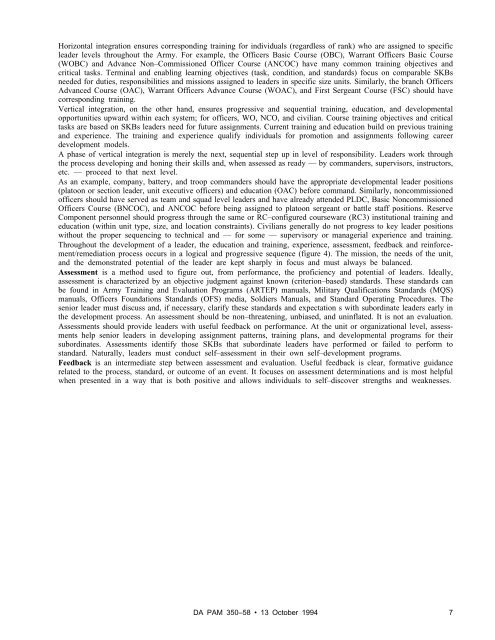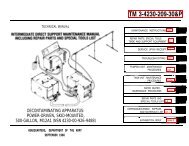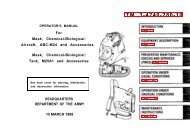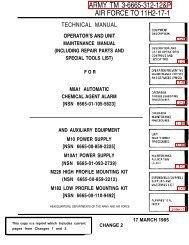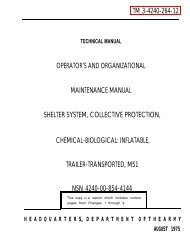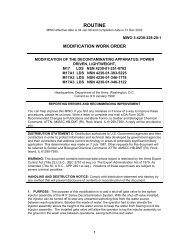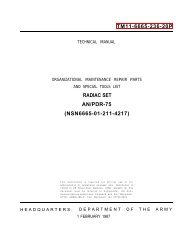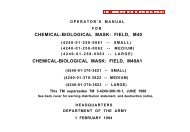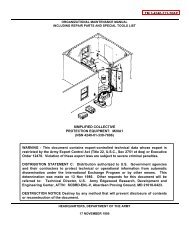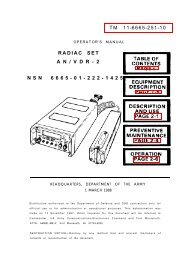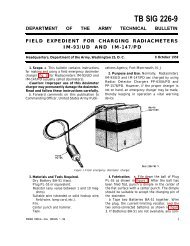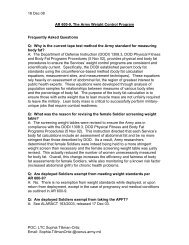LEADER DEVELOPMENT FOR AMERICA'S ARMY
LEADER DEVELOPMENT FOR AMERICA'S ARMY
LEADER DEVELOPMENT FOR AMERICA'S ARMY
You also want an ePaper? Increase the reach of your titles
YUMPU automatically turns print PDFs into web optimized ePapers that Google loves.
Horizontal integration ensures corresponding training for individuals (regardless of rank) who are assigned to specific<br />
leader levels throughout the Army. For example, the Officers Basic Course (OBC), Warrant Officers Basic Course<br />
(WOBC) and Advance Non–Commissioned Officer Course (ANCOC) have many common training objectives and<br />
critical tasks. Terminal and enabling learning objectives (task, condition, and standards) focus on comparable SKBs<br />
needed for duties, responsibilities and missions assigned to leaders in specific size units. Similarly, the branch Officers<br />
Advanced Course (OAC), Warrant Officers Advance Course (WOAC), and First Sergeant Course (FSC) should have<br />
corresponding training.<br />
Vertical integration, on the other hand, ensures progressive and sequential training, education, and developmental<br />
opportunities upward within each system; for officers, WO, NCO, and civilian. Course training objectives and critical<br />
tasks are based on SKBs leaders need for future assignments. Current training and education build on previous training<br />
and experience. The training and experience qualify individuals for promotion and assignments following career<br />
development models.<br />
A phase of vertical integration is merely the next, sequential step up in level of responsibility. Leaders work through<br />
the process developing and honing their skills and, when assessed as ready — by commanders, supervisors, instructors,<br />
etc. — proceed to that next level.<br />
As an example, company, battery, and troop commanders should have the appropriate developmental leader positions<br />
(platoon or section leader, unit executive officers) and education (OAC) before command. Similarly, noncommissioned<br />
officers should have served as team and squad level leaders and have already attended PLDC, Basic Noncommissioned<br />
Officers Course (BNCOC), and ANCOC before being assigned to platoon sergeant or battle staff positions. Reserve<br />
Component personnel should progress through the same or RC–configured courseware (RC3) institutional training and<br />
education (within unit type, size, and location constraints). Civilians generally do not progress to key leader positions<br />
without the proper sequencing to technical and — for some — supervisory or managerial experience and training.<br />
Throughout the development of a leader, the education and training, experience, assessment, feedback and reinforcement/remediation<br />
process occurs in a logical and progressive sequence (figure 4). The mission, the needs of the unit,<br />
and the demonstrated potential of the leader are kept sharply in focus and must always be balanced.<br />
Assessment is a method used to figure out, from performance, the proficiency and potential of leaders. Ideally,<br />
assessment is characterized by an objective judgment against known (criterion–based) standards. These standards can<br />
be found in Army Training and Evaluation Programs (ARTEP) manuals, Military Qualifications Standards (MQS)<br />
manuals, Officers Foundations Standards (OFS) media, Soldiers Manuals, and Standard Operating Procedures. The<br />
senior leader must discuss and, if necessary, clarify these standards and expectation s with subordinate leaders early in<br />
the development process. An assessment should be non–threatening, unbiased, and uninflated. It is not an evaluation.<br />
Assessments should provide leaders with useful feedback on performance. At the unit or organizational level, assessments<br />
help senior leaders in developing assignment patterns, training plans, and developmental programs for their<br />
subordinates. Assessments identify those SKBs that subordinate leaders have performed or failed to perform to<br />
standard. Naturally, leaders must conduct self–assessment in their own self–development programs.<br />
Feedback is an intermediate step between assessment and evaluation. Useful feedback is clear, formative guidance<br />
related to the process, standard, or outcome of an event. It focuses on assessment determinations and is most helpful<br />
when presented in a way that is both positive and allows individuals to self–discover strengths and weaknesses.<br />
DA PAM 350–58 • 13 October 1994<br />
7


